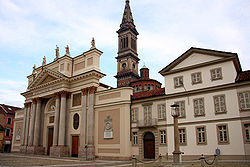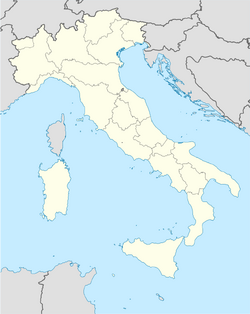| Main | Births etc |
|---|
| Alessandria | |||
|---|---|---|---|
| — Comune — | |||
| Comune di Alessandria | |||
| Alessandria Cathedral on the Piazza del Duomo | |||
|
|||
| Coordinates: Coordinates: | |||
| Country | Italy | ||
| Region | Piedmont | ||
| Province | Alessandria (AL) | ||
| Frazioni | Spinetta Marengo, Castelceriolo, Lobbi, San Giuliano Nuovo, San Giuliano Vecchio, Mandrogne, Cascinagrossa, Litta Parodi, Valle San Bartolomeo, San Michele | ||
| Government | |||
| • Mayor | Maria Rita Rossa ([[List of political parties in Italy|PD]]) | ||
| Area | |||
| • Total | 204 km2 (79 sq mi) | ||
| Elevation | 95 m (312 ft) | ||
| Population (31 August 2009) | |||
| • Total | 93,922 | ||
| • Density | 460/km2 (1,200/sq mi) | ||
| Demonym | Alessandrini, Mandrogni | ||
| Time zone | CET (UTC+1) | ||
| • Summer (DST) | CEST (UTC+2) | ||
| Postal code | 15121-15122 | ||
| Dialing code | 0131 | ||
| Patron saint | San Baudolino | ||
| Saint day | November 10 | ||
| Website | Official website | ||
Alessandria listen (help·info) (Lissandria in Piedmontese) is a city and comune in Piedmont, Italy, and the capital of the Province of Alessandria. The city is sited on the alluvial plain between the Tanaro and the Bormida rivers, about 90 kilometres (56 miles) southeast of Turin.
Alessandria is also a major railway hub.
History[]
Alessandria was founded in 1168 with a charter as a free commune; it was sited upon a preexisting urban nucleus, to serve as a stronghold for the Lombard League, defending the traditional liberties of the communes of northern Italy against the Imperial forces of Frederick Barbarossa. Alessandria stood in the territories of the marchese of Montferrat, a staunch ally of the Emperor, with a name assumed in 1168 to honor the Emperor's opponent, Pope Alexander III. In 1174–75 the fortress was sorely tested by Imperial siege and stood fast. A legend (related in Umberto Eco's book Baudolino, and which recalls one concerning Bishop Herculanus’ successful defense of Perugia several centuries earlier) says it was saved by a quick-witted peasant, Gagliaudo: he fed his cow with the last grain remaining within the city, then took it outside the city walls until he reached the Imperial camp. Here he was captured, and his cow cut open to be cooked: when the Imperials found the cow's stomach filled with grain, Gagliaudo was asked the reason to waste such a rich meal. He answered that he was forced to feed his cow with grain because there was such a lot of it, and no room to place it within the city. The Emperor, fearing that the siege would last too long, left Alessandria free. (Malaria was probably the real cause of his departure.) A statue of Gagliaudo can be found on the left corner of the city cathedral.
Alessandria entered into jealous conflicts with the older communes of the region, in particular with Asti.[1]
In 1348 Alessandria fell into the hands of the Visconti and passed with their possessions to the Sforza, following the career of Milan, until 1707, when it was ceded to the House of Savoy and henceforth formed part of Piedmont. The new domination was evidenced by the construction of a new big Cittadella on the left side of the river Tanaro, across from the city.
With Napoleon's success at the Battle of Marengo (1800), Alessandria fell to France and became the capital of the Napoleonic Département of Marengo. During this period another substantial fort was built to the north of the city containing impressive and substantial barracks which are still used as a military headquarters and stores (2006). The remains of a second fort to the south of the city (Cristo quarter) have been sliced in two by a railway (Forte ferrovia); a third one still remains in the middle of the same quarter (Forte Acqui).
From 1814 Alessandria was Savoyard territory once more, part of the Kingdom of Sardinia. During the years of the Risorgimento, Alessandria was an active center of the liberals.
In a suburb, Spinetta Marengo, the Battle of Marengo is reenacted annually, on June 14.
Alessandria was the first capital of an Italian province to be governed by a Socialist: the clockmaker Paolo Sacco was elected mayor on July 25, 1899.
Alessandria was a tactical military target during World War II and was subjected to intense Allied bombing, the most serious being the raids of April 30, 1944, with 238 dead and hundreds wounded, and April 5, 1945, with 160 deaths, among them 60 children from the children's asylum in Via Gagliaudo. On end of that month the city was liberated from the German occupation (1943–1945) by the partisan resistance and troops of Brazilian Expeditionary Force.
On November 6, 1994 the Tanaro flooded a good part of the city, causing major damage, especially in the Orti quarter.
Jewish history[]
The first known Jews in Alessandria, named Abraham (son of Joseph Vitale de Sacredoti Cohen) opened a loan bank in or about 1490.[2] In 1590, the Jews were expelled from the Duchy of Milan, and one of Abraham's descendants travelled to Madrid, which ruled the Duchy, and was permitted to stay in the town due to a large sum owed him by the government. Of the 230 Jews living in the city in 1684, 170 were members of the Vitale family. The Jewish Ghetto was established in 1724. Between 1796 to 1814, among the rest of Italian Jewry, the city Jewish congregation was emancipated, under French influence. According to Benito Mussolini's census in 1938, the town had 101 Jews.[2] On December 13, 1943, The synagogue on Via Milano was attacked by supporters of the German-imposed Italian Social Republic. Books and manuscripts were taken out of the synagogue and were set on fire at Piazza Rattazzi. In total, 48 Jews were sent from the province of Alessandria to death, most of them in Auschwitz.[2] List of Alessandria Rabbis.
Geography[]
Climate[]
Alessandria is located in a humid subtropical climate (Köppen climate classification Cfa), the city has moderately cold winters and hot, sultry summers. Rainfall is moderate, with two minimums (summer and winter) and two maximums in autumn and spring
| Climate data for Alessandria | |||||||||||||
|---|---|---|---|---|---|---|---|---|---|---|---|---|---|
| Month | Jan | Feb | Mar | Apr | May | Jun | Jul | Aug | Sep | Oct | Nov | Dec | Year |
| Average high °C (°F) | 3.2 (37.8) |
6.6 (43.9) |
12.6 (54.6) |
17.7 (63.8) |
22.4 (72.3) |
26.7 (80.1) |
29.5 (85.1) |
28.6 (83.5) |
24.1 (75.4) |
16.9 (62.5) |
9.4 (48.9) |
4.4 (40.0) |
16.8 (62.3) |
| Average low °C (°F) | −2.4 (27.7) |
−0.6 (31.0) |
3.7 (38.6) |
8.0 (46.4) |
12.4 (54.3) |
16.2 (61.1) |
18.5 (65.3) |
17.9 (64.2) |
14.5 (58.1) |
9.3 (48.7) |
3.9 (39.1) |
−0.4 (31.3) |
8.4 (47.1) |
| Precipitation mm (inches) | 38 (1.5) |
37.1 (1.46) |
54.1 (2.13) |
64 (2.52) |
59.9 (2.36) |
47 (1.85) |
32 (1.26) |
36.1 (1.42) |
42.9 (1.69) |
74.2 (2.92) |
72.1 (2.84) |
46 (1.81) |
603.3 (23.75) |
| Source: Intellicast[3] | |||||||||||||
Main sights[]
Monuments[]
- Citadella Militare (18th century)
- The church of Santa Maria di Castello (14th and 15th century)
- The church of Santa Maria del Carmine (15th century)
- Palazzo Ghilini (1733)
- Università del Piemonte Orientale
Museums[]
- The Marengo Battle Museum
- Antiquarium Forum Fulvii
- Sale d'arte
- I percorsi del Museo Civico
- Museo del Fiume
- Museo di Scienze Naturali e Planetario
- Museo Etnografico "C'era una volta"
- Museo del Cappello Borsalino
Events[]
- The annual Fraskettando SkaBluesJazz Festival (official web site), which takes place on the first weekend of July, has showcased the Blues Brothers, Eddie Floyd, Al Di Meola, Taj Mahal, Soft Machine, Mario Biondi, Mick Abrahams & Clive Bunker and many others.
- Michele Pittaluga International Classical Guitar Competition Premio Città di Alessandria
- International Rally "Madonnina dei Centauri".official web site
Transport[]
Alessandria railway station, opened in 1850, forms part of the Turin–Genoa railway. It is also a junction for six other lines, to Piacenza, Novara, Pavia, Cavallermaggiore, Ovada and San Giuseppe di Cairo, respectively.
People born in Alessandria[]
- Saint Baudolino (c.700–c.740), hermit of Forum Fulvii
- Francesco Filiberti (15th century), sculptor
- Georgius Merula (c. 1430–1494), humanist
- Giovanni Mazzoni (15th–16th century), painter
- Giorgio Soleri (16th century), painter
- Giuseppe Vermiglio (16th–17th centuries), painter
- Giovanni Migliara (1785–1837), painter
- Andrea Vochieri (1796–1833), patriot
- Urbano Rattazzi (1808–1873), statesman of the Risorgimento
- Francesco Faà di Bruno (1825–1888), mathematician and priest
- Virginia Marini (1844–1918), actress
- Angelo Morbelli (1854–1919), painter
- Blessed Teresa Grillo Michel (1855–1944), founder of the Congregation of the Little Sisters of Divine Providence.
- Sibilla Aleramo (1876–1960), painter
- Pietro Morando (1889–1980), painter
- Giovanni Ferrari (1907–1982), footballer
- Walter Audisio (1909–1973), partisan
- Franco Sassi (1912–1993), painter
- Umberto Eco (born 1932), writer
- Gianni Rivera (born 1943), footballer
- Gian Luigi Bonelli (1908–2001), Italian comic book author and writer
- Marta Gastini (born 1989), actress
- José Rinaldi (born 1925 - Argentina, 06/2011)
Twin towns — Sister cities[]
Alessandria is twinned with:
 Argenteuil, France, since 1960
Argenteuil, France, since 1960 Jericho, West Bank, since 2004
Jericho, West Bank, since 2004Hradec Králové, Czech Republic, since 1961
Karlovac, Croatia, since 1963
Rosario, Argentina, since 1988[4]
Alba Iulia, Romania, since 1990
See also[]
- Villa del Foro, a western suburb of the town which was the site of a Roman settlement.
References[]
- ^ "Alessandria – LoveToKnow 1911". www.1911encyclopedia.org. http://www.1911encyclopedia.org/Alessandria. Retrieved 2009-10-10.
- ^ a b c Alessandria
- ^ "Alessandria historic weather averages". The Casaccia Center of Enea. http://www.intellicast.com/Local/History.aspx?location=ITXX0106. Retrieved 26 September 2009.
- ^ "Town Twinning Agreements". Municipalidad de Rosario - Buenos Aires 711. http://www.rosario.gov.ar/mr/mri/www/city-city-program/town-twinning-agreements. Retrieved 2014-10-14.
External links[]
- The official website of the city council (Italian)
- Guide to Alessandria city – Information, phone numbers and useful link
- Travel Guide to Alessandria
- discount for young people of Alessandria (Archived 2009-10-25) (Italian)
Template:Province of Alessandria
| This page uses content from the English language Wikipedia. The original content was at Alessandria. The list of authors can be seen in the page history. As with this Familypedia wiki, the content of Wikipedia is available under the Creative Commons License. |



